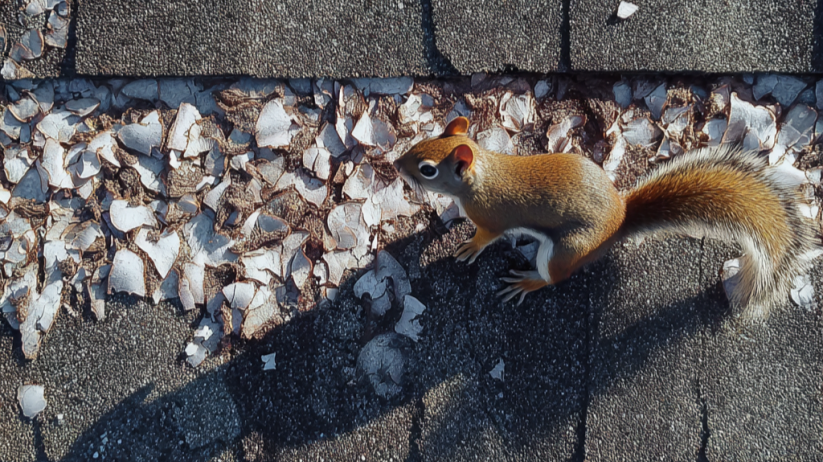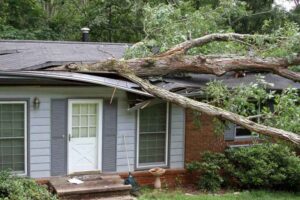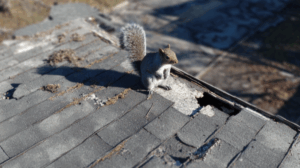Not all pets are welcome—especially the kind that move into your attic without an invitation. In Bethany Beach, DE, we hear from homeowners every year dealing with roof damage caused by squirrels, raccoons, birds, or woodpeckers. One day you hear scratching in the ceiling. Next, you’re patching holes in the siding or replacing attic insulation.
The truth is, these animals are resourceful. They know how to spot weaknesses in your roof, and once they find one, they dig in—literally. Whether it’s a small gap in your soffit, a loose vent cover, or wood siding soft enough for a woodpecker to drill into, they’ll find a way.
At Grand Exteriors, we see it all the time. And in this blog, we’ll show you what to look out for, what to expect from your insurance, and how to keep animals out for good.
What You’ll Learn in This Blog
- Why wildlife targets roofing and siding in coastal Delaware
- What common signs of animal damage to look for
- Whether animal-related roof damage is covered under homeowners insurance
- Practical steps for prevention and control of wildlife damage
- How Grand Exteriors repairs and wildlife-proofs your home
Need professional eyes on a suspicious roof issue? Schedule your free inspection with Grand Exteriors.

Why Wildlife Damage Happens So Often in Coastal Areas
Your Roof Isn’t Built to Keep Out Wildlife
Your roof protects you from the weather, but it’s not always ready to stand up to squirrels with sharp teeth or raccoons with strong paws. These animals are opportunists. They only need a small gap, a loose vent, or an unsealed edge to get inside.
Once inside your attic or behind your siding, they can chew wires, tear insulation, or create nests that trap moisture and mold.
Bethany Beach Homes Are Prime Targets
In areas like Bethany Beach, we see more animal intrusion than many inland towns. That’s because:
- Homes are closer to wooded areas and natural wildlife paths
- Mild winters mean animals stay active longer
- Flat or low-sloped roofs common in coastal designs offer easy access
- Many homes still use older materials that are easier for wildlife to damage
All it takes is one soft spot, and wildlife moves in fast.
What to Know Before You Repair Animal Damage
Insurance Coverage Depends on How the Damage Happened
Many homeowners ask, “Is animal damage to a roof covered under homeowners insurance?” The answer depends on how the damage occurred.
- If the damage was sudden—like a raccoon tearing open a vent—insurance may cover it.
- If the damage developed over time—like long-term bird nesting—it may be considered a maintenance issue and not covered.
Before you file a claim, review your policy and talk to your insurance provider. Keep photos and documentation from any inspections.
Repair Costs Can Vary Widely
Some wildlife damage is minor and quick to repair. But once animals get inside your home, the damage can quickly escalate to attic insulation, wiring, structural supports, or even moisture issues from blocked ventilation. The sooner you identify the damage, the less costly it usually is.
Not All Materials Are Wildlife-Resistant
Homes with wood siding, vinyl soffits, or basic plastic venting are more vulnerable. These materials are easier for animals to chew through, peck at, or pull apart. If you’ve been asking how to prevent woodpeckers from damaging wood siding, the material itself is often the root of the problem.
How to Stop Animals from Exploiting Your Roof’s Weak Spots
1. Start with a Thorough Roof and Siding Inspection
Whether it’s from the ground or a drone, inspecting your home’s exterior can reveal early warning signs like:
- Gnawed soffits or fascia
- Loose vents or flashing
- Holes in siding
- Nesting materials in gutters
- Droppings near entry points
We recommend at least two inspections per year—especially after storms or seasonal changes.
2. Upgrade Problem Areas with Wildlife-Resistant Materials
Investing in durable materials pays off in prevention. Here’s what we recommend:
| Vulnerable Area | Standard Material | Recommended Upgrade |
| Soffits & Fascia | Vinyl | Aluminum or composite |
| Siding | Cedar/Wood | Fiber cement or engineered wood |
| Vents | Plastic/mesh | Stainless steel covers/screens |
These changes make it far more difficult for animals to access your attic or wall cavities.
3. Trim Trees and Clear the Perimeter
Animals use branches as highways to your roof. Keep limbs at least 6–8 feet away from your home. Clean out your gutters and install guards to prevent nesting and reduce moisture that attracts insects and animals.
4. Act Quickly When You Notice Wildlife Activity
The longer you wait, the worse it gets. What starts as a bird nest can turn into blocked ventilation, mold, or damaged framing. If you hear scratching, see siding damage, or notice droppings near your soffits—take action right away.
How Grand Exteriors Solves Wildlife Roof Damage
We Repair Damage—and Stop It From Coming Back
At Grand Exteriors, we don’t just patch a hole and move on. We look at the whole system:
- Where did the animals enter?
- What materials made it possible?
- What upgrades will permanently solve the problem?
Our repairs are always backed by strong materials and real solutions—not temporary fixes.
Wildlife-Resistant Materials We Use
| Component | Product Used |
| Siding | James Hardie fiber cement or LP SmartSide |
| Soffits/Fascia | Aluminum or PVC composite panels |
| Vents | Stainless steel mesh & reinforced covers |
| Trim/Flashing | Engineered wood or treated pine |
Warranty and Long-Term Support
All of our workmanship is backed by a 10-year warranty. Plus, we provide first-year follow-up inspections to make sure your home stays secure.

Wildlife Roof Damage: Questions Delaware Homeowners Are Asking
We talk to homeowners every week in and around Bethany Beach who are dealing with everything from strange attic noises to full-on roof damage caused by animals. If you’re wondering what to look for or how to handle it, here are the most common questions—and what you need to know.
Is animal damage to a roof covered under homeowners insurance?
Animal damage to a roof may be covered under homeowners insurance if it was sudden and accidental. Most policies will not cover gradual damage caused by long-term neglect or ignored maintenance issues, so acting quickly is important.
Does insurance cover damage to roof vents and siding from animals?
Yes, insurance can cover damage to roof vents and siding caused by animals, but it depends on your policy and how the damage occurred. If it was caused by a single event or intrusion, it’s more likely to be eligible than damage that built up over time.
What’s the best way to prevent birds from damaging my roof?
The best way to prevent bird damage to your roof is to seal vulnerable entry points and keep gutters clean to discourage nesting. Adding metal vent covers and using bird deterrents can also stop problems before they start.
How do I stop woodpeckers from damaging my siding?
To stop woodpeckers from damaging siding, you need to replace soft wood siding with fiber cement or engineered materials. These harder surfaces are less appealing to woodpeckers and won’t attract insects, which are often the reason birds peck in the first place.
Can raccoons or squirrels get into my attic through the roof?
Yes, raccoons and squirrels can get into your attic through roofline gaps, soffits, vents, or damaged fascia. Once inside, they often cause damage to insulation, wiring, and other critical components.
Does Grand Exteriors handle animal-related roof repairs?
Yes, Grand Exteriors repairs animal-related roof damage and installs materials designed to keep wildlife out. We inspect your entire exterior, fix the damage, and provide long-term solutions to prevent repeat intrusions.
Final Thoughts: Secure Your Roof Before Wildlife Finds Its Way In
In coastal areas like Bethany Beach, wildlife is always nearby. And they’re surprisingly good at spotting the weak links in your home’s exterior. Whether it’s a lifted shingle, exposed soffit, or aging siding, animals know how to get in—and they won’t wait for an invitation.
At Grand Exteriors, we help you find those weak points before animals do. From inspection to repair to prevention, we handle the full process. If you’ve heard scratching in the attic or seen siding damage around your roofline, now’s the time to act.
Schedule your free inspection today. We’ll make sure your roof protects your home—and nothing else.




